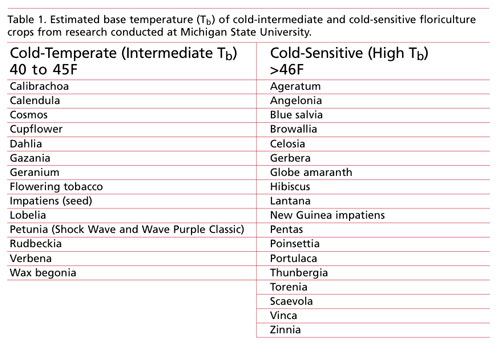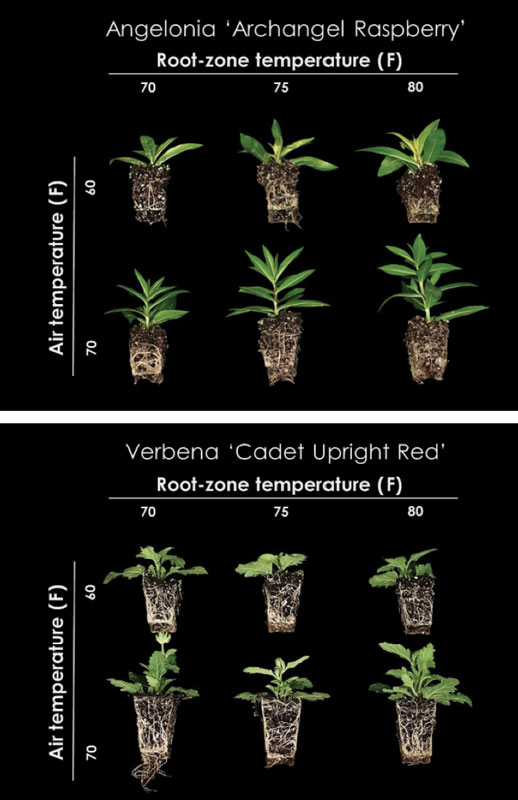11/1/2021
Rooting Cold-Intermediate and Cold-Sensitive Greenhouse Crops
Annika Kohler & Roberto Lopez
Unlike cold-tolerant crops, which have a base temperature (Tb) <39F (<4C), cold-intermediate and cold-sensitive crops are categorized as having a Tb between 39 and 45F (4 and 7C) and above 45F (7C), respectively (Table 1). At temperatures below the Tb, crops will not develop leaves or roots, thus delaying propaga-tion and production time. Therefore, during the winter and early spring, some growers heat their greenhouses well above 70F (21C) to maintain what they perceive as optimum temperatures for rooting. However, this isn’t necessary or beneficial for all crops and can negatively affect profitability. The use of energy curtains during the day, high air temp-eratures and low solar radiation can also lead to poor liner quality characterized as excessive stem elongation, weak stems and delayed rooting.
 In part one of this series, we determined that cold-tolerant crops could be successfully propagated at an air temperature of 60F (16C) when a root-zone temperature of at least 75F (24C) was maintained. Now we investigate the same parameters used in part one on cold-intermediate and cold-sensitive crops.
In part one of this series, we determined that cold-tolerant crops could be successfully propagated at an air temperature of 60F (16C) when a root-zone temperature of at least 75F (24C) was maintained. Now we investigate the same parameters used in part one on cold-intermediate and cold-sensitive crops.
The experiment
Unrooted stem-tip cuttings of cold-intermediate Geranium Moxie! Deep Rose (Geranium interspecific), Kwik Kombo Pink Lemonade Mix [Petunia Dekko Star Rose (Petunia ×hybrida), Lobelia Techno Heat Light Blue Improved (Lobelia erinus), Calibrachoa Callie Yellow Improved (Calibrachoa ×hybrida)], and Verbena Cadet Upright Red (Verbena ×hybrida), as well as cold-sensitive Angelonia Archangel Raspberry (Angelonia angustifolia), Lantana Landmark Sunrise Rose Improved (Lantana camara), New Guinea Impatiens Clockwork White Improved (Impatiens hawkeri), Portulaca Cupcake Carrot and Colorblast Lemon Twist (Portulaca grandiflora), Scaevola Scalora Brilliant (Scaevola aemula), and Thunbergia Sunny Lemon Star (Thunbergia alata) were received from a commercial supplier.
Cuttings were inserted into 72-cell trays filled with a 1:1 mixture of soilless substrate (70% peat moss, 21% perlite, 9% vermiculite) and medium perlite. All trays were placed in a glass-glazed greenhouse with an air temperature set point of 70F (21C) and bench-top root-zone heating of 75F (24C). Supplemental lighting from high-pressure sodium lamps provided 62 ± 6 µmol•m–2•s–1 of supplemental light when the outdoor light intensity was below 440 µmol•m–2•s–1. A daily light integral of 5 mol•m–2•d–1 was achieved by placing a ~50% shade cloth over the benches for six days during callusing.
Post-callus, all trays were assigned to one of six temperature treatments, which were comprised of an air temperature of either 60 or 70F (16 or 21C) and among three root-zone temperatures of 70, 75 or 80F (21, 24 or 27C). A daily light integral of 11 to 12 mol•m–2•d–1 was maintained for root development via supplemental lighting. A vapor pressure deficit of 0.3 kPa was maintained via steam injection for the entire study.
Overhead mist was used intermittently based on the light intensity to provide 60 ppm N and was reduced every few days and then turned off one week prior to data collection. During the last week, plants were hand irrigated with 60 ppm N as necessary. After 14 or 16 days of treatments, 10 liners per genus and treatment were collected, and the soilless substrate was rinsed from the roots, and roots and shoots were divided and dried to record root and shoot dry mass.
Results
Air and root-zone temperature interacted to influence the stem length of angelonia (Figure 1) and lantana, while air or root-zone temperature independently influenced the stem length of portulaca, thunbergia and verbena (Figure 2).
For example, when the air temperature increased from 60 to 70F and the root-zone temperature increased from 70 to 80F, angelonia liners were 8% to 23% taller. At an air temperature of 70F, portulaca and thunbergia liners were 11% and 47% taller, respectively, as the root-zone temperature increased from 70 to 80F.
 In addition, stem length of portulaca and thunbergia increased by 40% and 169%, respectively, as air temperature increased from 60 to 70F. Stem length of geranium and scaevola liners was not affected by temperature treatments.
In addition, stem length of portulaca and thunbergia increased by 40% and 169%, respectively, as air temperature increased from 60 to 70F. Stem length of geranium and scaevola liners was not affected by temperature treatments.
The root dry mass of angelonia and portulaca (cold-sensitive crops) was influenced by the interaction of air and root-zone temperature, whereas geranium, Kwik Kombo, lantana, thunbergia and verbena were influenced by air or root-zone temperature individually. The root dry mass of angelonia at a root-zone temperature of 70F increased by 81% as the air temperature increased from 60 to 70F, whereas at a root-zone heating set point of 80F, the root dry mass was similar between air temperatures.
Figure 1. Angelonia Archangel Raspberry, a cold-sensitive crop, 14 days after placement in one of six different temperature treatments consisting of three root-zone temperatures and two air temperatures.
For geranium (cold-intermediate crop), grown at an air temperature of 70F, increasing the root-zone temperature from 70 to 80F led to a 40% reduction in root dry mass. However, the root dry mass at an air temperature of 60F across all root-zone temperatures was similar and produced an adequate root mass. Interestingly, the root dry mass of New Guinea impatiens and scaevola wasn’t affected by temperature treatments.
The shoot dry mass of angelonia was influenced by both the interaction of air and root-zone temperature, while portulaca and thunbergia were influenced by only air temperature and Kwik Kombo, lantana, New Guinea impatiens and verbena were influenced by root-zone temperature alone.
Figure 2. Verbena Cadet Upright Red, a cold-intermediate crop, 14 days after placement in one of six different temperature treatments consisting of three root-zone temperatures and two air temperatures.
For example, at an air and root-zone temperature of 70 and 70F, respectively, the shoot dry mass of angelonia was 40% greater than at an air temperature of 60F. Furthermore, at an air temperature of 60F, the shoot dry mass of angelonia was 41% greater when the root-zone temperature was raised from 70 to 80F. Similarly, increasing the root-zone temperature from 70 to 75F led to a 14% increase in the shoot dry mass of lantana at an air temperature of 60F. However, the shoot dry mass of geranium and scaevola weren’t influenced by temperature treatments.
Take-home message
Reducing the air temperature did not negatively affect the quality or morphology of geranium, New Guinea impatiens, scaevola or verbena. Thus, these crops may be successfully propagated under an air temperature of 60F when a root-zone temperature of at least 75F is maintained.
Similarly, angelonia, Kwik Kombo, lantana, portulaca and thunbergia rooted under these conditions may result in a more compact liner, and a delay in premature flowering. In some cases, a root-zone temperature of 80F was too high for some crops and thus further studies need to be conducted to determine if an optimal temperature exists between 75 to 80F.
Additionally, lantana may also be grown at an air temperature of 70F with a root-zone temperature of 70 to 75F to encourage better root growth without affecting stem elongation or shoot dry mass. GT
Acknowledgements: The authors gratefully acknowledge Michigan State University’s Project GREEEN, The Western Michigan Greenhouse Growers Association, The Metro Detroit Flower Growers Association and the Fred C. Gloeckner Foundation for funding, as well as horticultural companies for providing support of Michigan State University’s floriculture research. We would also like to thank Nate DuRussel for greenhouse assistance and data collection, as well as Ball Horticultural Company, Syngenta Flowers and Dümmen Orange for donating plant material. This research was supported by the USDA National Institute of Food and Agriculture, Hatch project MICL02472.
Annika Kohler is a Research Technician and Roberto Lopez is an Associate Professor and Controlled Environment/Floriculture Extension Specialist in the Department of Horticulture at Michigan State University.